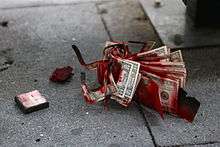Dye pack

A dye pack is a radio-controlled incendiary device used by banks to foil a bank robbery by causing stolen cash to be permanently marked with dye shortly after a robbery. In most cases, a dye pack is placed in a hollowed-out space within a stack of banknotes, usually $10 or $20 bills. This stack of bills looks and feels similar to a real one, with technology allowing for the manufacturing of flexible dye packs which are difficult to detect by handling the stack.[1][2]
When the marked stack of bills is not used, it is stored next to a magnetic plate near a bank cashier, in standby or safe mode, ready to be handed over to a bank robber by a bank employee. When it is removed from the magnetic plate, the pack is armed, and once it leaves the building and passes through the door frame, a radio transmitter located at the door triggers a timer (typically at least 10 seconds), after which the dye pack explosively releases[3] an aerosol (usually of Disperse Red 9) and sometimes tear gas, intended to destroy the stolen money and mark the robber's body with a bright stain. The chemical reaction causing the explosion of the pack and the release of the dye creates high temperatures of about 200 °C (392 °F) which further discourages a criminal from touching the pack or removing it from the bag or getaway vehicle.[1] Dye packs are used to foil robberies in over 75% of banks in the U.S.[1]
In England, a robber who fled a bank in Regent Street laughing "haha, I've got all the money", was enveloped in "a red cloud" of dye as he ran away down Shaftesbury Avenue.[4]
See also
References
- 1 2 3 "I've heard of bank robbers being foiled by a 'dye pack' put in their money stash. What is a 'dye pack'?". How Stuff Works. Retrieved May 21, 2012.
- ↑ US5485143A, Keniston, "Security dye pack having flexible heat-resistant chemical pouch", published 1993
- ↑ "Thieves caught after dye pack explodes in bank heist". New York Post. Retrieved October 23, 2016.
- ↑ "Jailed, laughing robber who was covered with security dye". London Evening Standard. 14 July 2014. p. 5.